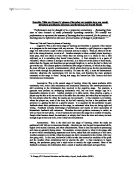Associative: This is the second stage of leaning, where the leaner performs skills moderately well, with a little consistency and occasional continuity. The learner practices the skill according to the information they received in the cognitive stage. For example, a gymnast may perform an arobspring moderately well, but not have straight legs or a presentable entrance or exit. Another example is in table tennis, when playing a game, a player may be able to hit on one side of the table then the other, but when they are required to hit one extreme after the other, the results are not successful. A final example is in hockey, where the player can, most of the time, hit the ball correctly, but has a few problems with accuracy i.e. getting the ball to a specific player. It is essential for the performer to gain feedback about their performance at this stage, to understand what they are doing right and wrong. Feedback includes knowledge of performance and results to allow association of kinaesthetic feedback with outcomes. Therefore the main guidance necessary is verbal, as well as visual for new skills. A lot of learners do not leave this stage for a number of reasons. People often become bored, de-motivated, or simply don’t have the time and money to train enough to get to the next level, even if they have the potential.
Autonomous: This is the third and last stage of learning, where the tasks are performed with little or no conscious thought. Attention can now be paid to specialised skills, higher level tactical elements, and other considerations. There is less time spent on processing and more on generally being aware. For example, a tennis player is, when in this stage, able to serve whilst contemplating opponents next move, rather than the mechanics of the serve. Another example is in cricket, where the player can bowl consistently to the wicket, with very few going wide. In this case, the bowler is able to take into account to condition of the pitch and the weather when considering how to execute the skill. A final example is in figure skating, the performer going into a triple salco at exactly the right moment. Most of the feedback is internal, but information from a coach or teacher adds detail and specificity.
People often go back to the last stage for various reasons, and then move to the next stage again. Therefore the stages of learning could be described as a continuum. It is also a continuum in the way that feedback gradually goes from visual and verbal to internal and kinaesthetic.
They often have to return to the cognitive stage to check the mental image they have.
Anxiety, lack of motivation, boredom, emotional problems, fatigue, lack of training, are all reasons for reversibility. A performer may also be focused on one aspect of the technique, which has disrupted learning. So a simple way of doing a skill may be taught, and as the performer adjusts to the higher level, they return to the cognitive stage. For example, when throwing a Javelin, after adding in the run-up, the actual throw may decrease in distance.
Conclusions
It is important to know the different stages of learning, as a coach or teacher, when you are structuring sport practices. For example, if you know that the learner is likely to be in the cognitive phase, and then it is important to know that they will require an exact demonstration of how to execute each skill. They will also need to repeat it many times to be able to progress into the associative stage, and often have to have it broken down as much as possible, so each stage of the skill itself can first be put into the associative stage before the whole skill can. For example, a long jump has to be broken down into the take off, the landing, the length of the run up, and the speed of the run up. Coaches will have to be aware of telling them where they are going wrong (but with enough encouragement to motivate them), and as they progress to the autonomous stage, getting them to notice their own errors, like why they are not hitting the board with enough force. It is essential for coaches to know these stages so that they may not expect too much too quickly of their pupils, and therefore overload and discourage them.
The cognitive stage often involves verbal repetition, which often helps with the mental picture and transferring the information into the long-term memory, where it is more likely to be an autonomous skill. For example, in dance, the learner may repeat a sequence of; “side together, side hop”. They are likely to have problems in processing information concerning their limbs, and so that is the main element they pay attention to. The same type of situation occurs in basketball, when a beginner dribbles the ball, they will pay attention to where the ball is, rather than where they’re going. The more complex the skill is, the longer it will take to learn the requirements of it.
I conclude that these stages are essential for the development of any sport so that the leaner may be given enough information for motivation purposes, but not too much for overload and discouragement.
Bibliography
Advanced PE for Edexel (2000) by Frank Galligan, Colin Maskery, Jon Spence, David Howe, Tim Barry, Andy Ruston, and Dee Crawford.
Physical Education and the study of sport, fourth edition (2000) by Bob Davis, Ros Bull, Jan Roscoe and Dennis Roscoe.
Acquiring Skill in Sport (1992) by Bob Sharp.
Advanced Studies in Physical Education and Sport (1996) Edited by Paul Beashel and John Taylor.
B. Knapp p325 Physical Education and the study of sport, fourth edition (2000).






